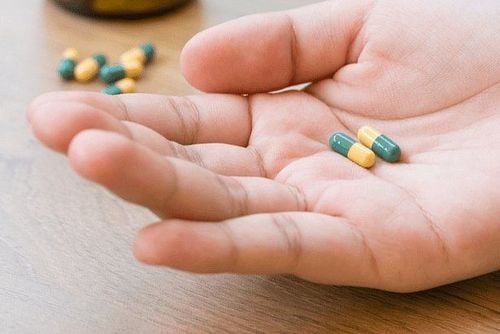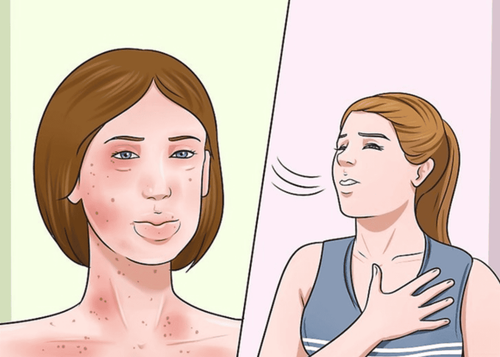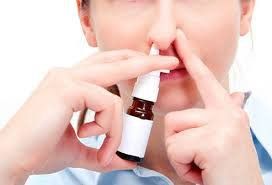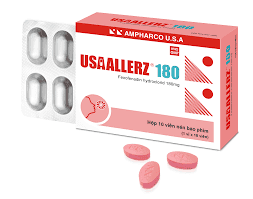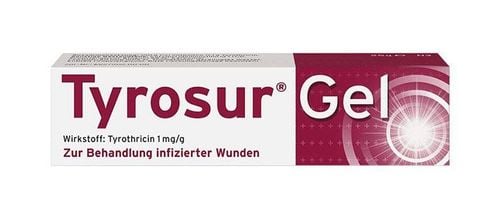This is an automatically translated article.
In the treatment of symptoms of allergic rhinitis such as sneezing, runny nose, itchy throat, ... doctors often use Gimfastnew 180 mg. So what is Gimfastnew? How does the drug work? What should be noted when using Gimfastnew?
1. Effects of the drug Gimfastnew.
Gimfastnew 180 mg drug with the main active ingredient is Fexofenadine hydrochloride (Fexofenadine) 180 mg, commonly used to treat seasonal allergic rhinitis, idiopathic chronic urticaria in both adults and children over 6 years old. Fexofenadine belongs to the group of second-generation antihistamines, which have specific and selective antagonistic effects on peripheral H1 receptors. Fexofenadine is an active metabolite of terfenadine, but does not inhibit the potassium channel involved in myocardial repolarization, and therefore is not cardiotoxic. Fexofenadine has no significant effect on acetylcholine antagonism, dopamine antagonism and no alpha-1 and beta-adrenergic receptor blockade. Fexofenadine has a rapid, long-acting effect because it binds slowly to the H1-receptor, forming a stable complex and dissociating slowly. At therapeutic doses, Gimfastnew does not induce sleep or affect the central nervous system.
Gimfastnew is usually indicated for the treatment of:
Relief of symptoms of seasonal allergies (hay fever) in adults and children, relief of symptoms of allergic rhinitis such as itching, sneezing, runny or stuffy nose, itchy eyes, watery eyes, red face,... Treatment of itchy skin and rashes caused by a condition called chronic idiopathic urticaria in adults and children 6 years of age and older .
2. How to use the drug Gimfastnew
Gimfastnew 180 mg is made in the form of film-coated tablets, for oral use.
Dosage:
Treatment of symptoms of seasonal allergic rhinitis:
Adults and children 12 years of age and older: 180 mg/day in 1-2 divided doses. Patients with renal impairment: starting dose 60 mg/time x 1 time/day. Children 6-11 years old: 30 mg/time x 2 times/day. Children 6 - 11 years old with renal failure: starting dose 30 mg/time x 1 time/day. Treatment of chronic idiopathic urticaria:
Adults and children 12 years of age and older: 60 mg/time x 2 times/day. Patients with renal impairment: starting dose 60 mg/time x 1 time/day. Children 6-11 years old: 30 mg/time x 2 times/day. Children 6 - 11 years old with renal failure: starting dose 30 mg/time x 1 time/day. Note, do not use for children under 6 years old or people who are sensitive to any ingredient of the drug.
3. Note when using the drug Gimfastnew
3.1. Side effects Gimfastnew 180 can cause some of the following side effects:
Nervous: Fatigue, headache, dizziness, drowsiness or insomnia,... Digestion: Nausea, indigestion. Other: Viral infections such as cold virus, flu virus, menstrual pain, upper respiratory tract infection, itchy throat, cough, fever, otitis media, sinusitis, back pain,... Undesirable effects of Gimfastnew drug Usually mild, only about 2% of patients have to stop taking the drug due to the side effects of the drug. However, when experiencing serious or prolonged unusual problems, it is also necessary to contact emergency medical care for timely support.
3.2. Drug Interactions Fexofenadine is not metabolized in the liver, so Gimfastnew does not interact with drugs metabolized by the liver.
Antacids
Gimfastnew should not be used at the same time as antacids containing aluminum and magnesium, because it can reduce the effect of Fexofenadine.
In healthy adults, administration of 120 mg Fexofenadine within 15 minutes of administration of an aluminum and magnesium antacid can reduce Fexofenadine AUC by 41% and Cmax by 43%.
Erythromycin and Ketoconazole:
Co-administration of Gimfastnew with ketoconazole or erythromycin will increase the plasma concentration of Fexofenadine 2-3 times. In contrast, Fexofenadine did not affect the pharmacokinetics of either drug.
Gimfastnew should not be taken with fruit juices such as grapefruit, oranges and apples, as juices may reduce the bioavailability and exposure of Fexofenadine.
3.3. Note when using Gimfastnew drug Gimfastnew drug use for special subjects:
Pregnant women, nursing mothers: Because there have not been adequate studies on pregnant women, Gimfastnew should only be used for pregnant women when they are pregnant. weigh benefits-risk factors. Children: Recommended for children 6 years and older. The safety and efficacy of Fexofenadine in children under 6 years of age have not been established. Elderly: No dose adjustment is necessary except in patients with renal impairment. Drivers, operating machines: Fexofenadine is less drowsy, but it is still necessary to use caution when doing jobs that require alertness and high concentration. The drug does not have the same cardiotoxicity as terfenadine, however, careful monitoring is still needed when Gimfastnew is used in people who already have cardiovascular risk or have long QT syndrome - QT interval (time since onset of Q wave) to the end of the T wave, representing the pre-existing ventricular depolarization and repolarization time. Do not self-medicate with other antihistamines while using Fexofenadine. Fexofenadine is less likely to cause drowsiness, but caution is still needed when driving, operating machinery or doing tasks that require alertness and high concentration. Gimfastnew should be discontinued at least 24-48 hours before conducting intradermal antigen tests. Gimfastnew 180 mg medicine is commonly used to treat symptoms of allergic rhinitis such as itching, sneezing, runny or stuffy nose, itchy eyes/redness, watery eyes,... or urticaria urticaria, rash. In parallel with the use of drugs, attention should be paid to limiting exposure to allergens for the best treatment effect.
Please dial HOTLINE for more information or register for an appointment HERE. Download MyVinmec app to make appointments faster and to manage your bookings easily.




